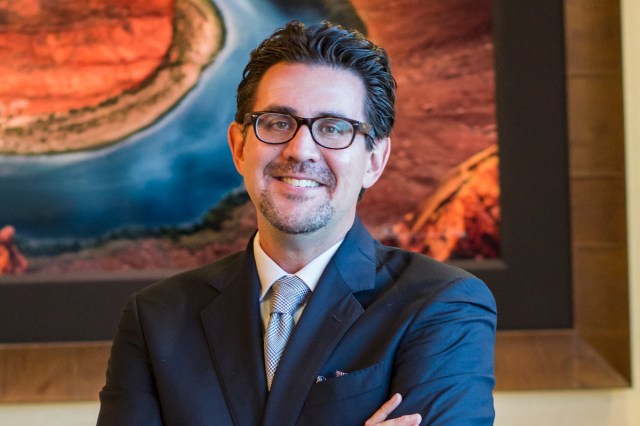
When tickets for “Hamilton” went on sale in April, hundreds of people lined up around The Smith Center for the Performing Arts for the chance to see the smash-hit Broadway musical. Within hours, most of the 63,000 tickets for the four-week run were sold out. The runaway success of “Hamilton” in Southern Nevada is due to the show’s critical accolades and overwhelming popularity, of course, but it is also a testament to The Smith Center itself.
Since opening in 2012, The Smith Center’s thoughtful design and amenities have attracted many world-renowned performing artists while providing a new home for the Nevada Ballet Theatre and the Las Vegas Philharmonic. Our community has embraced The Smith Center, which Pollstar ranks among top 10 performing arts centers in the world. In just the past few months, productions of “The Color Purple” and “Andrew Lloyd Webber’s Love Never Dies” ranked among Pollstar’s top five weekly rankings for ticket sales in theaters with fewer than 5,000 seats. There is little doubt that “Hamilton” will continue that run of top-grossing Broadway productions at The Smith Center.
The only ticket that might have been harder to get than “Hamilton” in June, was for the Vegas Golden Knights as they extended their improbable postseason run into the Stanley Cup Final. The Golden Knights were THE story of professional sports this season as they shattered every expansion team record for success. Then, they surely outdid even the most optimistic expectations by getting within three wins of a championship. During the season-long stretch of success, Southern Nevada embraced the Golden Knights, selling out T-Mobile Arena game after game, and rocketing team merchandise sales and TV ratings toward the top of the league.
Both The Smith Center and the Golden Knights have been unqualified successes, but it wasn’t always a given that they would even exist to become the cherished community assets that they are today. Without vision and dedication from key community leaders, Southern Nevada might still be the largest city without a performing arts center or a major professional sports franchise.
The idea for a world-class performing arts center first took seed more than 20 years ago when it was proposed by local business and community leaders. The project gained momentum over the next decade as support was gathered and plans were made. In the mid-2000s, major pieces started to fall into place. State legislation created a car rental fee to provide half of the project financing under a private-public partnership. The Clark County Commission approved the fee, and the City of Las Vegas provided additional bond funding and donated the land at Symphony Park.
The private fundraising campaign reached its goal thanks in large part to the Donald W. Reynolds Foundation’s commitment of $150 million, the largest philanthropic gift in state history. The foundation chairman and his wife, Fred and Mary Smith, became The Smith Center Namesakes. At the time of the 2009 groundbreaking, the Los Angeles Times called it a “cultural gamble,” both in terms of the economy at the time and the ability of Southern Nevada to support the arts. It would have been easy to put the project on hold and wait for better days ahead. Yet the project pushed forward and opened in 2012 to rave reviews and widespread community support.
The Golden Knights faced their own doubts long before they even had a name. When team owners Bill Foley and the Maloof family began their campaign for an expansion NHL team in Southern Nevada in 2015, many in the hockey world questioned the viability of a franchise in a non-traditional market whose residents were mostly from somewhere else. To prove the market’s commitment to the NHL, the owners began a season ticket deposit campaign with an initial goal of 10,000 deposits. That number was reached within two months, and the new goal of 16,000 was ultimately reached for the inaugural season. That was enough to convince the NHL, and the Golden Knights were born. The early community enthusiasm carried well into the inaugural season, especially as the team quickly exceeded expectations. Most games sold out, and regular season home attendance averaged 18,042 fans per game, 103.9 percent of the arena’s seating capacity, ranking fourth-best in the NHL. During the playoff run, thousands of fans gathered at watch parties outside the arena and at several locations throughout the valley. Although the season ended in disappointment, Southern Nevada and the Golden Knights proved that what many thought impossible, was quite the opposite.
The Smith Center and the Golden Knights are now woven into the fabric of the Southern Nevada community, and it’s difficult to imagine a world without them. They provided shared experiences that have strengthened the bonds among our families, friends and neighbors. They instilled a new level of community pride and unity. They inspired us to imagine what could be. As we celebrate these relatively new community assets, we should remember and thank the people who made it happen; the visionaries who looked over the horizon and dreamed big; the doers who relied on patience and dedication to overcome doubt and obstacles to see their visions become realities. No longer the largest city without a performing arts center or a major professional sports team, we can check those off the list and look again to beyond the horizon at what comes next. Our community has accomplished so much in just the past 10 years, I can’t wait to see what we can dream into reality in the next 10.


